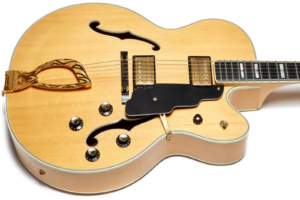
Introduction
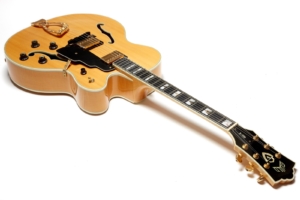
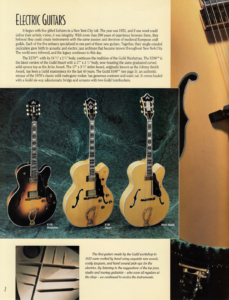
I did manage to score a very rare January 1994 price list while writing this review and in that document I found the X700 Stuart listed as New with a price of $3299 with the case an extra $175, and yes, Guitar companies were playing the “your new $3000 guitar doesn’t come with a case” game back then, too.
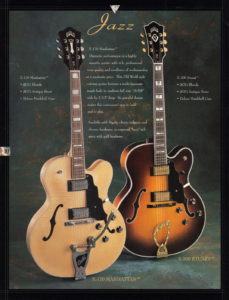
While I couldn’t find any reason for the name Stuart, I found it interesting that the X500 was also named Stuart and that the X700 took that name which may be explained by the X700 replacing the X500 as the king of the dual-pickup archtops.
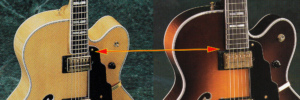
The 1997-1998 Guild Gallery magazine shows a blonde version of the X700 Stuart and includes the text stating that it boasts the same graduated carved solid spruce top as the Artist Award. By 1999 the catalog copy had been updated to state that the solid spruce top was sourced from AAA spruce, though the picture had remained the same blonde example shown in the previous catalogs.
In the 2000 Guild catalogs, both the Artist Award and X700 Stuarts had been redesigned by Bob Benedetto and were very different and much more expensive guitars. From the internal bracing to the inclusion of Benedetto A6 pickups, there’s a reason these later Benedetto X700s command the premium prices seen with them on the rare occasion that they show up for sale. To be clear, this is not a Benedetto X700.
Finish
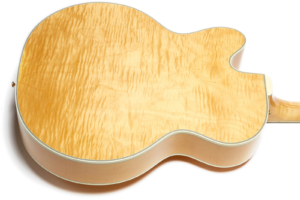
The X700 was only available in Blonde and Sunburst, but given how many one-off guitars I’ve seen over the years from Guild, it wouldn’t surprise me to see one in a different color. I have not seen any other color, but then these guitars don’t come up for sale very often.
Fretboard and Neck
The headstock on this guitar is adorned with the G-shield Guild logo which is common on higher-end Guilds. The headstock veneer looks to be ebony but whatever it is it’s a rich dark black that looks great contrasted with the gold tuners. Although the shape of the headstock is not different than the one on my 1997 Guild Starfire III, the X700’s headstock sports a three-layer binding that also contrasts beautifully with the black veneer.
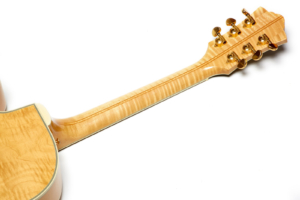
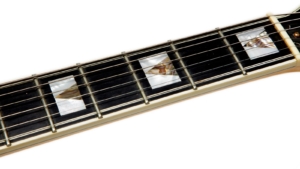
The 1997 catalog lists the X700 as having a 12″ radius, and though I measured 14″, I could easily attribute the discrepancy to user error since the difference between 12″ and 14″ is slight.
The catalogs list the X700 as having a 1 11/16″ width neck at the nut, but mine measured an easy 1 3/4″ with a .87″ depth that make the guitar a joy to play unless you don’t like huge necks. The frets are .04″ high by .085″ wide which is typical of most Guild electric guitars from the mid-late ’90s.
The frets on my sample have some sharp ends, but as of this writing (January 2021) the guitar is 24 years old so I’m going to attribute that more to humidity variation in the wood than I am to the original fretwork. The fretboard was very dry when I got it, so I expect some slight change over time as it soaks up the bore oil and humidity in its new environment.
Build Quality
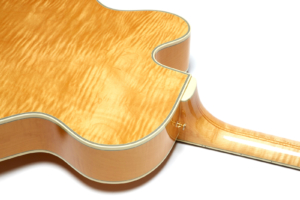
Speaking of binding, another one of the hallmarks of the higher-end Guild archtops is the addition of binding on the rim of the f-holes. Though not a luthier by any stretch of the imagination, I have to imagine that putting 3-layer binding on the f-holes must be a laborious task. I also happen to think that it looks great and adds to the exclusivity of the model.
If you play enough Guild guitars you start to see and feel the similarities between them, and sometimes it feels like many of them are just variations on a theme. So it was with the X700 for me and I couldn’t really discern what the big deal was with this guitar over the X500 at first. When it comes down to it, I’d say that the big deal is the top.
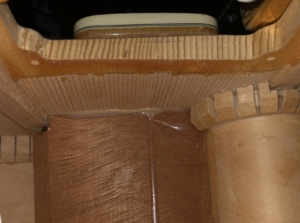
There are no sound posts nor a sound block in this guitar, making it a true hollowbody. Like the Aritist Award, there are two braces that go from the neck of the upper bout to the bottom of the lower bout running parallel on either side of the pickups along the underside of the top.
The solid top on this guitar is thicker than on the laminate X500s or the X175 I’ve owned (this pic is of my ’80s X175 top), but there’s no doubt that a laminated top would be more structurally stable and thus be able to be thinner.
The marketing material for the X700 makes a point of saying that the top is the same as the one used on the Artist Award. I have an Artist Award (AA) from roughly the same era, but there is no easy way for me to tell if they’re similar in construction because the AA does not have gigantic holes cut into it for pickups. That’s kind of the AA’s defining feature, though, so there’s no way for me to tell if it’s made with the same thickness as the X700. I could argue that the AA wouldn’t need to be as thick without the holes in the top, but again there’s no way for me to tell without sawing my AA in half. I love a good experiment, but even I have my limits.
The question in my mind is if the tradeoff between the thick solid X700 top is worth the price of admission over the thinner laminate top of the X175 or X500 in order to get a solid-topped guitar. I honestly don’t know the answer to that, but I will say that my first impression when playing this guitar was that it wasn’t worth the hype. More on that later, though.
Pickups
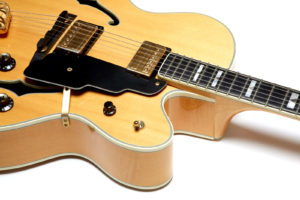
The vintage Guild HB1s had a chime to them that is hard to recreate and is a huge part of their magic. While I like the SD1s a lot, they don’t have that same sparkle and I think that’s part of what I find to be lacking in this guitar. While my older X175 and X500s were the same depth and had laminated tops, they had a magic quality to them that I don’t hear in this guitar and I think that’s in large part due to the pickups.
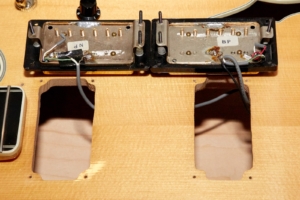
Electronics
The impression I get when looking at this guitar is that it’s a slightly higher-end guitar that has all the same parts as most of the other Guilds from the same era. To test that theory, I pulled the wiring harness. As I suspected, at first glance there’s nothing terribly exciting to be found inside. The guitar has Seymour Duncan SD1 pickups as previously mentioned, and the harness looks just like a bunch of other Guilds that I’ve reviewed from the late ’90s.
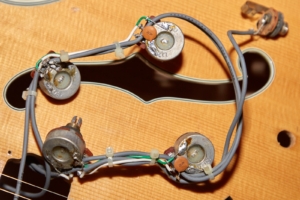
Wait… what?
That’s not a typo. After looking at the picture for far too long, it’s clear to me that three of the four pots are stamped with 5033 which is the Guild code for a 200k logarithmic taper pot. At first I thought I had to be wrong, but it actually explains some things that I’ll cover down in the Sound section, and I measured the tone pots with my Fluke multimeter. In a nutshell the use of 200k pots means that much of the treble is being filtered out of the tone.
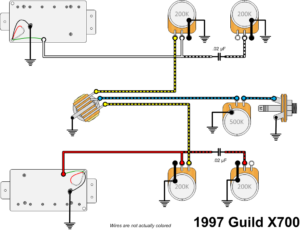
The tone capacitors are 203M-marked orange ceramic disc caps which translates to .02μF with a ±20% tolerance.
Hardware
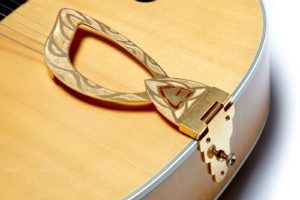
Since the pickups tend to encounter contact with the player’s hand or at least their sweat, they tend to wear in a way that looks unfortunate, especially when compared withe the beautiful tailpiece. Gold really adds to the perceived elegance of the instrument when new, but Guild’s plating technique has always seemed to wear even faster than competing brands.
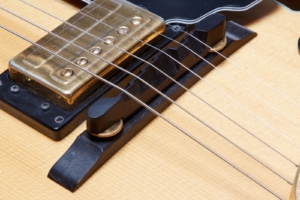
As with most of the arched top Guilds from this period, the pick guard drives me nuts because it sits on top of the pickup rings and is thus (in my opinion anyway) far too close to the strings. This causes it to be in my way when playing. That might not be the case for you if you play with a lighter touch, but apparently I play like a gorilla on a caffeine bender, so the guard would have to go.
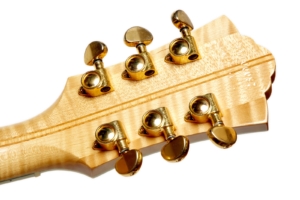
Sound
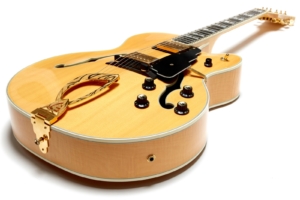
Is this too much guitar for me? Maybe, but I don’t think that’s what’s colored my opinion, because as I noted in #2 above, I’ve had the pleasure of playing a lot of Guilds, and compared to some of those guitars, this one does not measure up. Honestly, my gut impression is that this was a failed experiment where they put a nicer top on an X500 and tried to upsell it as something special but lost the magic by using SD1 pickups.
In 1997 Fender was still only a couple of years into owning Guild, so there may have been some growing pain issues, but I have to wonder if the performance of this guitar is what led Fender to bring in Robert Benedetto to redesign it.
ODS100 (round)
7th Chords
Open 7th Chords
Open Chords #1
Open Chords #2
RC120 (round)
12th Fret Noodle 1
12th Fret Noodle 2
For each recording I cycle through the neck pickup, both pickups, and finally the bridge pickup. All knobs on the guitar are on 10 at all times. Both of the Noodling recordings were done with only the neck pickup.
This guitar is a feedback machine with a special penchant for the open A string, and I mean sitting alone in a room with an amp at what I’d call “bedroom level” (I hate that term), the guitar will start to wail when I let go of the strings. It’s really bad. Still, it’s a hollowbody, and feedback is one of those things you have to learn to live with when playing hollowbodies.
The guitar is more lively unplugged than my X175, likely due to the solid spruce top and lack of a sound block. That makes me think that the guitar might do well with different pickups because though it outperforms my X175 unplugged, I much prefer the X175 plugged in. While I really like the SD1 pickups in a solidbody, I’m not sure they’d be my first choice for a jazz guitar.
After being disappointed with the recording, I went back and pulled the harness as shown in the Electronics section above, and then it all made sense. 200k pots on a humbucker-equipped guitar is a bit odd, though I’ve seen Guild use them on tone pots from time to time. Still, on this big jazz box of a guitar, putting 200k pots in it makes it even woofier than normal and that’s why I don’t like the sound.
I will say that after letting this review sit for some months and coming back fresh, I rather liked the tone in the two noodle clips. That caused me to pull the guitar out again to see if I was wrong in my written assessment above. I was not, and I’ll talk more about that in the conclusion.
Playability
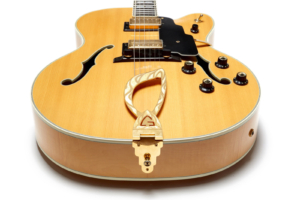
My biggest beef from a playability standpoint is the pick guard, but that’s an easy thing to fix with two minutes and a screwdriver. Just make sure you remember where you stashed it and for the love all that’s holy, tape the screws to the back of the thing because you’ll never find those again when you go to sell it in the future.
I like guitars with master volumes, and I love the look of the Guild master volume but I hate how small that knob is in practice. I wish they had moved the toggle switch to the upper bout like it is on Starfire IIIs then had the master volume on the bottom, but whining about design choices from 25 years ago is a waste of time.
Really, though, this is a very nice high-end guitar and it plays like a dream with it’s perfectly shaped 1 3/4″ neck. Almost any of my complaints about tone can be dialed in with a good amp and for its intended purpose I think it’s a great guitar. Not the best, but still pretty great.
Conclusion
I wanted to love this guitar, and I didn’t, but to be fair I’m an absolutely spoiled collector with some amazing guitars so my opinion may not be that of a normal person. Still, these guitars are not inexpensive, so I think for the price it should be amazing. It’s really, very nice; maybe even great, but I didn’t think it was amazing.
This is also not a guitar that was made for someone like me. What does that mean? I’m not a jazz player. I’d love to be, but I’m just not. I’ve gone to events with 4-piece jazz quartets and I always watch enthralled by the guitarist’s skill and I love the tones they pull from these guitars. Then I go home and crank up my Super Strat with whatever ridiculous ’80s patch I’m favoring that day and I work on peeling the paint from the walls with my sonic power. I’m just not a jazz guy. I took lessons from a jazz guy for years but it just didn’t take.
However…
When I got my Artist Award I was blown away by it because that guitar is amazing. I only bring that up because it shows that I can appreciate a great jazz guitar, but perhaps comparing anything to an Artist Award is unfair. Still, I like my ’80s X175 better, too. And my ’90s X170. I think you get the idea.
Is this a beautiful well made Westerly Guild jazz guitar? Absolutely. Does it play like a dream? Yes. If I played jazz more would I be happy with it? Probably.
It’s a stunningly beautiful guitar that is a joy to play but the simple truth is that I like the sound from my X175 better, though to be fair they have quite different pickups and the X700 has a noticably more lively sound unplugged no doubt due to the solid top and lack of a sound post.
At the very least I think the guitar would be vastly improved with 500k pots, and I would absolutely recommend that as a change before swapping out the pickups. Actually, I’d probably just sell it and play the Guilds in my collection that inspire me, and in the end that’s my review: It’s a beautiful guitar that just didn’t inspire me, likely because of the high expectations created by my corral of even greater Guilds.
My primary mistake was in judging the guitar from a point of view of a rock guitarist, and the X175 with its more biting tone makes for a better match with crunch like you might want for Rock or Rockabilly, but not for jazz.
When I had another player play the guitar seated facing me, the differences were far more pronounced and the X700 put out a much richer woodier tone both unplugged and amplified. The X700 also projected its sound acoustically in a way that the X175 with its laminated top and sound block simply could not match
The guitar still has an odd place in my collection since it’s outclassed by the Artist Award and Guild Benedetto X700, but I’m definitely more impressed by the guitar having listened to it with a new perspective.
Even for its intended use, I do still feel that the pots should be 500k and I’m not sure the stock pickups were the right choice, but dialed in properly the guitar is absolutely capable of some great jazz tones, especially in the hands of a real jazz player.
Donate: PayPal Crypto:
ETH: 0x0AC57f8e0A49dc06Ed4f7926d169342ec4FCd461
Doge: DFWpLqMr6QF67t4wRzvTtNd8UDwjGTQBGs

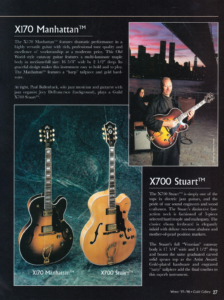
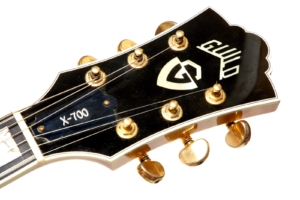

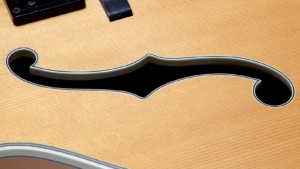
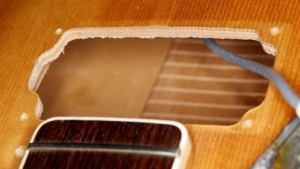
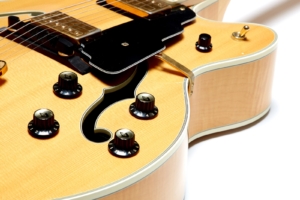
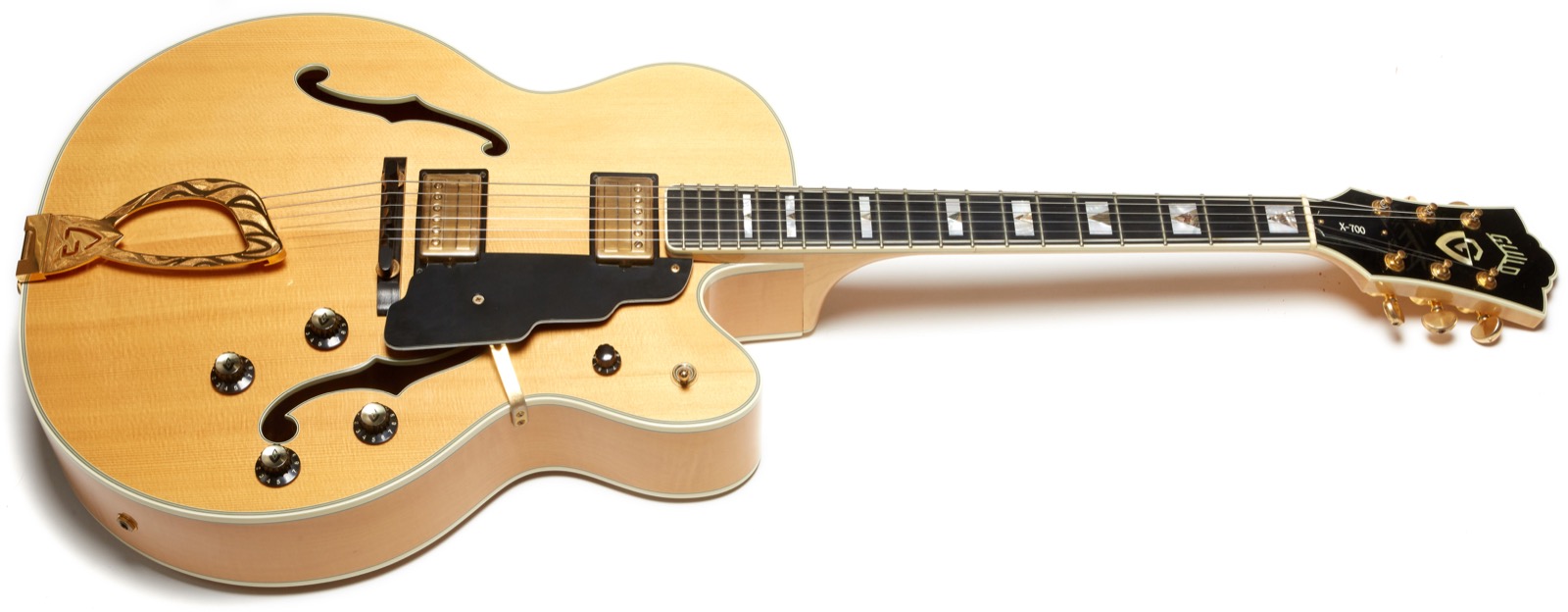

My ’94 X 500 had an X 700 neck (verified by H. Moust) …
Guild X 700- SUPER GUITAR!!!!!!!!
Hi, Gary…
I just joined, mostly because I just purchased a Benedetto Artist Award.
I’ve always been a primarily acoustic player, and though I’m no jazzbo, I do play quite a lot of early swing jazz and gypsy jazz. I own a prototype Macaferri style show guitar that was made by Ibanez’ master luthier under Macaferri’s direction, made during the last period of his life. From 1978 to 1987, it was the only jazz guitar I owned.
I purchased a 1939 Gibson L-7 arch top, which later became the prototype for Gibson’s L-7 reissues. I also worked for Gibson’s acoustic division in Bozeman, Montana twice, 10 years apart. In between, I worked for them off and on as an independent contractor.
I say my first Artist Award in 1969, and to me, it was the perfect all-round guitar for the music I like most to play. It was far too expensive then, so I contented myself with my D-28, and later a better pre-war Gibsson AJ.
Since that first AA was the only one I had ever seen and played, but had always wanted, when my AA suddenly appeared, I jumped on it. Like yours, mine is a blonde.
It’s every thing you said it is, except for one big exception; the back on mine isn’t pressed and laminated.
It’s solid European maple, with 2 diamond shaped mahogany cleats set very cleanly in the inside of the back to keep the center seam from coming open if the glue joints ever fail.
The back is hand carved, just like the top, but the carving is different from Gibsons. The recurve cuts are flatter, less pronounced, while the thinnest part of the cuts are thinner.
I’m sure the sides are laminated, however. It’s very hard to tell, but using laminated sides makes good production sense, and laminated sides are much less prone to cracking from age and stress.
A hand-carved back is the reason why the AA was so much more expensive and so limited. Anyone who can carve a top well can carve a solid back, but it literally takes twice the time to cave both.
The difference in tone however, is substantial. A well-carved solid back vibrates in harmonic response to the carved top, and in the hands of a skilled luthier, the back can be voiced to match the top. Carving the back can also correct any imbalance of tone the top may have. A carved top creates the tone of the guitar, and the carved back reinforces that tone while adding some additional tone of its own to the sound.
In the case of the Artist Award, it makes the sound woodier, smoother, and sustains more than pressed wood. More like a good flattop while retaining the quick clear response of an arch top.
To me, that’s very similar to a handmade Benedetto at a lot less cost. I’ve only played one Benedetto, one of his newer designs, and while it was superior, the Guild is very close to it. Bob mush be a very good teacher.
Benedetto also redesigned the paickguard, and replaced the old DeArmond pickup with one that looks identical to one of his Seymour Duncan-made pickups.
The only difference I can see between the two is the Guild pickup has a gold cover plate that doesn’t bear his signature. and the cover is gold plated metal, not the wood-like composition cover used on the Benedettos.
The pickup is one of the best things about this guitar. On a high-end arch top, the pickup is only there to boost the sound level just enough to allow the guitar to be clearly heard without the need of slamming the guitar hard. Any top-range guitar can achieve that volume with no pickup, but it takes a lot of exertion to do it all night long. The pickup took a lot of hard work out of the job. It allowed a guitar player to play lead lines with no force on the flatpick.
Men came equipped with a set of bronze wound acoustic strings on it, and when I plugged it in to an amp set flat on the clear channel, there was no difference in tone as I turned the volume up until it reached the point where the amp took over. Bronze strings work very well indeed. Nickel wounds would make for a stronger tone, but less woody and organic.
The Benedetto pickguard is prettier too. It fits the guitar better than the old stair-step guard,, and the single volume control is very smooth and unobtrusive.
The real deal to me is the tone. The Artist Award’s tone is very similar to the best Gibson L-5 postwar I ever played at much less cost and more overall attention to detail.
Mine came out of an estate sale, and the guy who first bought it must have been a collector, as it looks like it was never played and it still sounds rather green. Archtops require a lot of playing to break them in, and that’s what I do- I don’t buy ’em to collect them. I play all of mine a lot, every day.
I’m no real bonafide expert; I’ve just been playing actively for 59 years and got around a lot. Everything I know only comes from personal experience and observation.
Like Forrest Gump, I’ve always been around the right people at the right time all my life. The only reason I got the job at Gibson only came from the personal connections I made years before the factory in Montana was built, and the fact I owned an original Advanced Jumbo.
I plan to take the guitar up to Montana the next time I go visit Ren Ferguson, who’s an old friend. If he spots anything I didn’t, I’ll come back and give you his findings.
Finally, I’d like to say no one needs to be a jazz player to use and appreciate good arch tops. The guitars were designed to produce musical tone with more clarity and balance at higher volume than a flattop guitar could achieve at first, and they were favored just as much by the early country music musicians as the jazz players. Jazz was just the more popular music of the day. Even when the guitar became associated with tied to jazz, the arch top guitar never changed, and until the arrival of the Fender solid bodies, country musicians still played them a lot. They still do, along with blues players, folk players, and honky-tonkers. Even bluegrass players use them now.
They’re good for any style of music, played at any level of expertise. If a player prefers the acoustic sound over the electric sound, the only difference between an arch top and a flat top is mostly in the way the player plays the guitar.
When I first began playing one, I was in a bluegrass band and I only wanted a guitar that could be heard above the fiddle and the banjo. The arch top did it. My main influence on it was Mother Maybell Carter, who always used hers for the same reasons.
The Benedetto is 100% solid wood: back, top, and sides. I have an X700 Benedetto that I’m reviewing now, so stay tuned!
Very cool!
I really like your blog- it’s packed with good and valuable information and you’re a very good writer.
After writing my long rant, I stayed up for hours reading through all the catalog/price list info you have collected. It’s a real treasure trove resource that deserves to be permanent.
The Benedetto period was especially interesting for me. I’ve known bits & pieces of it for years, but the catalogs and price sheets paint a much more complicated relationship with Guild than I ever realized.
I hope you’ll do a review on the Artist Award eventually; it, too has a more complicated history than I ever knew.
Both the Stuart/X700 and the AA are obvious prestige guitars- every guitar company has always made 1 or 2, and they are never expected to be big sellers. The intent is always to brag about how good the company is as a maker. They’re a lot like show cars, intended to boost the sales of all the lesser models. Most often, though, these show ponies tend to come and go with the changing tastes of the times, then re-appear when buyer demand for them grows.
The Martin D-45 is an example; it was the top guitar Martin made for many years, then after WWII, dropped out of production for over 20 years before it came back. And when it did return, it was in stages. Martin dipped it’s toe in the water by introducing the D-41 first just to see if there was a market.
Not Guild. They stuck with their best, carefully integrated elements from them into newer instruments and kept making a few, even when there was no market for them. Both the Stuart and AA were always mentioned in their catalogs/price sheets, even when they were special orders. The strategy made Guild a remarkably uniform brand for a company with such a short history.
The company has always had a bumpy ride, and that always is attractive to collectors and guitar geeks. That Guild has survived for so long despite some radical changes in management while retaining is reputation for quality and relatively high prices is also unusual. Most of the time, these brands just disappear. Or come back after a long absence as imports. Gretsch is a good example.
I live in Idaho, far from the East Coast, and I never saw a Guild guitar in person until I enlisted in the Navy and was transferred to Norfolk in 1966. Once there, I was surprised at how much Guild ruled the market, especially with it’s high-end folk guitars. Before my transfer, I was stationed in San Diego, and in California, the Guilds just didn’t exist. I never saw any there I can remember.
There’s a lot of regionalism in all the guitar brands; Gibsons have always been heavily favored in the South, while in the West, it was always Fender and Martin. But there were always dealers who sold the others and the others were always easy to find. Not so with Guild until much later in its history.
That’s very interesting to me that a company that was very good and so well established could be so unknown on the other side of the country.